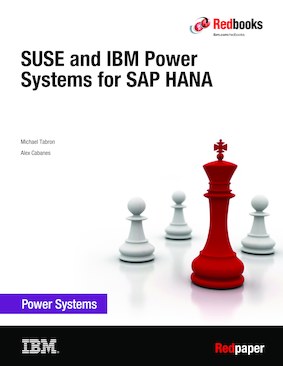SUSE and IBM Power Systems for SAP HANA
An IBM Redpaper publication
Published 24 November 2020

ISBN-10: 0738459216
ISBN-13: 9780738459219
IBM Form #: REDP-5620-00
(18 pages)
View online
Authors: Michael Tabron, Alex Cabanes
Abstract
For organizations charting their way forward in today's digital economy, the clear imperative is to find better ways of extracting more value from data. By gleaning insight from data regarding customer preferences and business operations, organizations can respond to demand more effectively and better deliver the experiences that today's customers want.
To this end, many organizations running SAP solutions seek to make the move to the SAP HANA database. SAP HANA offers the speed of in-memory data processing and the ability to combine transactions and analytics on a single platform for insight in real time.
However, considerations at the level of IT infrastructure can make or break the success of an SAP HANA implementation. What the database runs on, in other words, matters significantly.
This IBM® Redguide publication explores the value of deploying SAP HANA on SUSE Linux Enterprise Server for SAP Applications and the IBM Power platform with IBM POWER9™ processors. Both offerings are optimized to help your organization reap the rewards of SAP HANA while also transforming IT service delivery more generally.
Designed for enterprise-grade operations, SUSE Linux Enterprise Server for SAP Applications offers an open-source software-defined infrastructure (SDI) that is optimized for SAP workloads. Reliable, fast, and secure, it also supports the automation that is needed to substantially free up IT staff from service deployment and management duties.
Power Systems servers support SAP HANA implementations according to the SAP Tailored Data Center Integration (TDI) 5.0 specification. Optimized for scale-up and scale-out scenarios and built to support virtual persistent memory, Power Systems serves help you provision faster, scale affordably, and maximize uptime by persisting memory across virtual machines (VMs) and multiple SAP HANA instances.
Both SUSE and IBM have partnered with SAP for decades to fine-tune these offerings. Together, SUSE and IBM solutions offer a way forward for deploying, optimizing, and running SAP HANA implementations that is proven to be successful. This publication looks at various aspects of this combined offering in greater detail.
Table of contents
The challenge: Data and the drive to serve customers better
The value: Why run SAP HANA on SUSE and Power Systems servers
The deployment: Implementing SAP HANA
The partnership: IBM, SUSE, and co-innovation
The benefits: Conclusion
